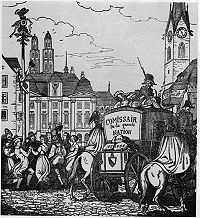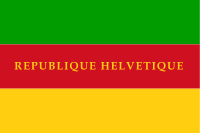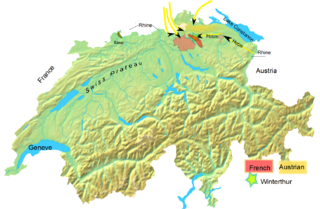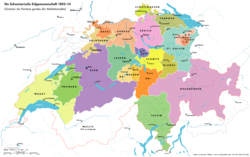- Switzerland in the Napoleonic era
-
History of Switzerland 
This article is part of a seriesEarly history Prehistory Roman era (200 BC–400) Alemannia · Burgundy (400–900) Swabia · Burgundy (900–1300) Old Swiss Confederacy Growth (1291–1516) Reformation (1516–1648) Ancien Régime (1648–1798) Transitional period Napoleonic era (1798–1814) Restoration (1814–1847) Modern history Federal state (1848) World Wars (1914–1945) Topical Military history Historiography
Switzerland Portal
During the French Revolutionary Wars, the revolutionary armies marched eastward, enveloping Switzerland in their battles against Austria. In 1798 Switzerland was completely overrun by the French and became the Helvetic Republic. The Helvetic Republic encountered severe economic and political problems. In 1798 the country became a battlefield of the Revolutionary Wars, culminating in the Battles of Zürich in 1799.
In 1803 Napoleon's Act of Mediation reestablished a Swiss Confederation that partially restored the sovereignty of the cantons, and the former tributary and allied territories of Aargau, Thurgau, Graubünden, St. Gallen, Vaud and Ticino became cantons with equal rights.
The Congress of Vienna of 1815 fully re-established Swiss independence and the European powers agreed to permanently recognise Swiss neutrality. At this time, the territory of Switzerland was increased for the last time, by the new cantons of Valais, Neuchâtel and Geneva.
The Restoration, the time leading up to the Sonderbundskrieg, was marked with turmoil, and the rural population struggling against the yoke of the urban centres, for example in the Züriputsch of 1839.
Contents
Fall of the Ancien Régime
Further information: French invasion of SwitzerlandOstrach – 1st Stockach – Pastrengo – Verona – Legnago – Magnano – Cassano – Winterthur – 1st Zurich – Trebbia – Mantua – Novi – Bergen – 2nd Zurich – Castricum – Wiesloch – Genoa – Hohentwiel – 2nd Stockach – Meßkirch – Biberach – Fort Bard – Montebello – Marengo – Höchstädt – Neuburg – Ampfing – Hohenlinden – Mincio – Copenhagen – Algeciras – Porto Ferrajo
Mediterranean Campaign – Egyptian Campaign – Swiss Campaign – Dutch Campaign The people of Zürich celebrate dancing around an Arbre de la liberté on the Münsterhof while the French carry off the treasury (1848 woodcut).
The people of Zürich celebrate dancing around an Arbre de la liberté on the Münsterhof while the French carry off the treasury (1848 woodcut).
During the last years of the Ancien Régime the growing conflicts throughout the Confederation (aristocratic cities against peasant farmers, Protestant against Catholic and canton against canton) had weakened and distracted the Diet. In Paris the Helvetian Club, founded in 1790 by several exiled Vaudois and Fribourgers, was the centre from which the ideas of the French Revolution were spread in the western part of the Confederation.[1] During the next eight years revolts sprang up across the Confederation and unlike earlier many were successful. In 1790 the Lower Valais rose against the upper districts. In 1791 Porrentruy rebelled against the Bishop of Basel and became the Rauracian republic in November 1792 and in 1793 the French department of the Mont Terrible. In 1795 St Gallen successfully revolted against the prince-abbot. These revolts were supported or encouraged by France, but the French army didn't directly attack the Confederation.
However, following the French success in the War of the First Coalition (1792–1797) against the aristocratic armies of Prussia and Austria, the time had come for direct action against the aristocratic Ancien Regime in Switzerland. In 1797 the districts of Chiavenna, Valtellina and Bormio, dependencies of the Three Leagues (an associate of the Confederation), revolted under the encouragement of France. They were quickly invaded and annexed to the Cisalpine Republic on 10 October 1797. In December of the same year the Bishopric of Basel was occupied and annexed.[2] On 9 December 1797 Frédéric-César de La Harpe, a member of the Helvetian Club from Vaud, asked France to invade Bern to protect Vaud. Seeing a chance to remove a feudal neighbor and gain Bern's wealth, France agreed.[1] By February 1798 French troops occupied Mulhouse and Biel/Bienne. Meanwhile, another army entered Vaud, when the "Lemanic republic" was proclaimed, and the Diet broke up in dismay without taking any steps to avert the coming storm. On 5 March troops entered Bern, deserted by her allies and distracted by quarrels within. With Bern, the stronghold of the aristocratic party, in revolutionary hands, the old Confederation collapsed. Within a month, the Confederation was under French control and all the associate members of the Confederation were gone.
Helvetic Republic
On 12 April 1798 121 cantonal deputies proclaimed the Helvetic Republic, "One and Indivisible". The new régime abolished cantonal sovereignty and feudal rights. The occupying forces established a centralised state based on the ideas of the French Revolution.
Before the Helvetic Republic, each individual canton had exercised complete sovereignty over its own territory or territories. Little central authority had existed, with matters concerning the country as a whole confined mainly to the Diet, a meeting of leading representatives from the cantons.[3]
The constitution of the Helvetic Republic came mainly from the design of Peter Ochs, a magistrate from Basel. It established a central two-chamber legislature which included the Grand Council (with 8 members per canton) and the Senate (4 members per canton). The executive, known as the Directory, comprised 5 members. The Constitution also established actual Swiss citizenship, as opposed to just citizenship of one's canton of birth.[3] With Swiss citizenship came the absolute freedom to settle in any canton, the political communes were now composed of all residents, and not merely of the burghers.[1] However, the community land and property remained with the former local burghers who were gathered together into the Bürgergemeinde.[4]
No general agreement existed about the future of Switzerland. Leading groups split into the Unitaires, who wanted a united republic, and the Federalists, who represented the old aristocracy and demanded a return to cantonal sovereignty. Coup-attempts became frequent, and the new régime had to rely on the French to survive. Furthermore, the occupying forces plundered many towns and villages. This made it difficult to establish a new working state.
Many Swiss citizens resisted these "progressive" ideas, particularly in the central areas of the country. Some of the more controversial aspects of the new regime limited freedom of worship, which outraged many of the more devout citizens. Several uprisings took place, with the three Forest Cantons (Uri, Schwyz and Unterwalden) rebelling in early 1798. The Schwyzers, under Alois von Reding, were crushed by the French on the heights of Morgarten in April and May, as were the Unterwaldners in August and September. Due to the destruction and plundering, the Swiss soon turned against the French.[1]
After the Forest Cantons uprising, some cantons were merged, thus reducing their anti-centralist effectiveness in the legislature. Uri, Schwyz, Zug and Unterwalden together became the canton of Waldstätten; Glarus and the Sarganserland became the canton of Linth, and Appenzell and St. Gallen combined as the canton of Säntis.
French Revolutionary Wars in Switzerland
In 1799, Switzerland became a battle-zone between the French, Austrian and Imperial Russian armies, with the locals supporting mainly the latter two, rejecting calls to fight with the French armies in the name of the Helvetic Republic.
Battle of Winterthur
The Battle of Winterthur (27 May 1799) was an important action between elements of the Army of the Danube, Massena's Army of Switzerland, and elements of the Habsburg army, commanded by the Swiss-born Friedrich Freiherr von Hotze. Winterthur lies 18 kilometers (11 mi) northeast of Zürich. Because of its position at the junction of seven cross-roads, the army that held the town controlled access to most of Switzerland and points crossing the Rhine into southern Germany.
Masséna sent the newly promoted General of Division Michel Ney and part of the Army of the Danube to Winterthur on 27 May 1799 to stop the Austrian advance from eastern Switzerland. If the Austrians succeeded in uniting Hotze's army from the east with Nauendorf's directly north of Zurich, and Archduke Charles' which lay to the north and west, the French would be dangerously encircled at Zurich.[5]
On the morning of 27 May, Hotze assembled his force into three columns and marched toward Winterthur. Opposite him, Michel Ney deployed his force around the heights, the so-called Ober-Winterthur, a ring of low-lying hills some 6 kilometers (4 mi) north of the city. The overall commander of the forward line, Jean Victor Tharreau, had informed Ney that he would send Jean-de-Dieu Soult's division to support him; Ney understood this to mean he was to make a stand along the entire outpost line, and that he would not be isolated. He expected his small force would receive reinforcements from Soult's division. Consequently, Ney directed the weakest brigade, under the command of Théodore Maxime Gazan, to move up a long valley toward Frauenfeld, and another brigade, under the command of Dominique Mansuy Roget, to take the right, preventing any Austrian flanking maneuver.[6]
By mid-morning, Hotze's advanced guard had encountered moderate French resistance first from the two brigades Ney had at his disposal.[7] The Austrian advance troops quickly over-ran the weaker brigade and took possession of the woods surrounding the village of Islikon. After securing the villages of Gundeschwil, Schottikon, Wiesendangen, and Stogen, further west of Islikon, Hotze deployed two of his columns facing the French front, while a third angled to the French right,[6] as Ney had expected he would.[7] Soult never appeared (he was later court-martialed for insubordination) and Ney withdrew his forces through Winterthur, regrouping with Tharreau's main force in the outskirts of Zurich.[8] A day later, Hotze's force united with the main Austrian force of Archduke Charles.[9]
Battles for Zürich
In the First Battle of Zürich, on 4–7 June 1799, approximately 45,000 French and 53,000 Austrians clashed on the plains around the city. On the left wing, Hotze had 20 battalions of infantry, plus support artillery, and 27 squadrons of cavalry, in total, 19,000 men. On the right wing, General Friedrich Joseph, Count of Nauendorf commanded another 18,000.[10] The battle cost both sides dearly; General of Brigade Cherin was killed, on the French side, and on the Austrian side, Feldzeugmeister (General of Infantry) Olivier, Count of Wallis, was killed. On the French side, 500 died, 800 were wounded and 300 captured; on the Austrian side, 730 killed, 1,470 wounded, and 2,200 captured. When the Austrians took the French positions in the city, they also captured over 150 guns.[11] Ultimately, French general André Masséna yielded the city to the Austrians, under Archduke Charles. Massena retreated beyond the Limmat river, where he managed to fortify his positions.[12] Hotze's force harassed their retreat, and secured the river shoreline.[13] Despite Hotze's aggressive harassment of the French retreat, Charles did not follow up on the withdrawal; Masséna established himself on the opposite bank of the Limmat without threat of pursuit from the main body of the Austrian Army, much to the annoyance of the Russian liaison officer, Alexander Ivanovich, Count Ostermann-Tolstoy.[14]
On 14 August 1799, a Russian force of 6,000 cavalry, 20,000 infantry, and 1,600 Cossacks, under Alexander Korsakov, joined Archduke Charles' force in Schaffhausen.[15] In a vice-like operation, together with the Russians, they would surround André Masséna's smaller army on the banks of the Limmat, where it had taken refuge the previous spring. To divert this attack, General Claude Lecourbe, attacked the pontoon bridges over which the Austrians crossed the Rhine, destroying most of them, and making the rest unusable.[16]
Before Charles could regroup, orders arrived from the Aulic Council, the imperial body in Vienna charged with conduct of war, to countermand his plan;[17] Charles' troops were to leave Zurich in the supposedly capable hands of Korsokov, re-cross the Rhine and march north to Mainz. Charles stalled this operation as long as he could, but eventually he had to concede to Vienna's orders. Consequently, the Russian troops under a novice general replaced the Austrian troops and their seasoned commander. Charles withdrew his force to the north of the Rhine. Although the order to Charles to recross the Rhine and march north was eventually countermanded, by the time such instructions reached him, they were too late to reverse.[18]
In the Second Battle of Zürich, the French regained control of the city, along with the rest of Switzerland. Notably, Massena out-generaled Korsakov; surrounded him, tricked him, and then took more than half his army prisoner, plus captured the baggage train and most of his cannons, and inflicted over 8,000 casualties.[19] Most of the fighting took place on both banks of the river Limmat up to the gates of Zürich, and part within the city itself. Zürich had declared itself neutral, and was spared general destruction. General Oudinot commanded the French forces on the right bank and general Joseph Mortier, those on the left.[20]
At the same time, Soult led a small force, some 150 musket-men, across the river Linth—the men held their muskets over their heads and waded across, through water to their chests—and protected the crossing site for the remainder of the force; Hotze was killed during this maneuver when Soult's men surprised him on an early morning reconnaissance.[21] By the time Alexander Suvorov arrived from northern Italy into St. Gallen in early October, the Austrians and the Russians had been pushed out and he was forced to lead his men over the Alps to the Voralberg, resulting in additional losses.[22]
Civil war and the end of the Republic
Instability in the Republic reached its peak in 1802–03—including the Stecklikrieg civil war of 1802. Together with local resistance, financial problems caused the Helvetic Republic to collapse, and its government took refuge in Lausanne. Due to the instability of the situation, the Helvetic Republic had over 6 constitutions in a period of 4 years.[3]
At that time Napoleon Bonaparte, then First Consul of France, summoned representatives of both sides to Paris in order to negotiate a solution. Although the Federalist representatives formed a minority at the conciliation conference, known as the "Helvetic Consulta"; Bonaparte characterised Switzerland as federal "by nature" and considered it unwise to force the area into any other constitutional framework.
On 19 February 1803, the Act of Mediation restored the cantons. With the abolition of the centralized state, Switzerland became a confederation once again.
The period of the Helvetic Republic is still very controversial within Switzerland.[23] It represents the first time that Switzerland as a unified country existed and a step toward the modern federal state. For the first time the population was defined as Swiss, not as members of a specific canton. For cantons like Vaud, Thurgau and Ticino the Republic was a time of political freedom from other cantons. However the Republic also marked a time of foreign domination and revolution. For the cantons of Bern, Schwyz and Nidwalden it was a time of military defeat followed by occupation. In 1995 the Federal Parliament chose to not celebrate the 200 year anniversary of the Helvetic Republic, but to allow individual cantons to celebrate if they wished.[23]
Act of Mediation
Swiss Confederation
Schweizerische Eidgenossenschaft
Confédération suisse
Confederazione SvizzeraClient of the First French Empire ← 
1803–1815  →
→Capital Lucerne Government Republic Legislature Tagsatzung Historical era Napoleonic Wars - Act of Mediation 19 February 1803 - Congress of Vienna 8 June 1815 The Swiss Confederation was re-established as a result of the Act of Mediation issued by Napoleon Bonaparte on 19 February 1803 in the aftermath of the Stecklikrieg. The period of Swiss history from 1803 to 1815 is itself known as Mediation. The act abolished the previous Helvetic Republic, which had existed since the invasion of Switzerland by French troops in March 1798. After the withdrawal of French troops in July 1802, the Republic collapsed (Stecklikrieg). The Act of Mediation was Napoleon's attempt at a compromise between the Ancien Regime and a Republic. This intermediary stage of Swiss history lasted until the Restoration of 1815.
In 1803 Napoleon's Act of Mediation partially restored the sovereignty of the cantons, and the former subject territories of Aargau, Thurgau, Vaud and Ticino became cantons with equal rights. Likewise, the Three Leagues, formerly an associate (Zogewandter Ort) but not a full member of the confederacy, became a full member as the canton of Graubünden. The city of St. Gallen, also historically an associate of the confederacy, along with its own former subject territories (and with those formerly belonging to the Abbey of Saint Gall) became a full member as the canton of St. Gallen. By contrast, the territories of Biel, Valais, the former Principality of Neuchatel (the later canton of Neuchatel), of the Bishopric of Basel (the later Bernese Jura) and of Geneva did not become part of the Swiss confederacy until the end of the Napoleonic era.
With Napoleon acting as a mediator and declaring that the natural political state of the Swiss is a Federation,[24] the Act of Mediation dissolved the Helvetic Republic and addressed many of the issues that had torn the Republic apart. It restored the original 13 members of the old Confederation and added 6 new cantons, two (St Gallen and Graubünden or Grisons) having been formerly "associates", and the four others being made up of the subject lands conquered at different times — Aargau (1415), Thurgau (1460), Ticino (1440, 1500, 1512), and Vaud (1536). In the Diet, six cantons which had a population of more than 100,000 (Bern, Zurich, Vaud, St Gallen, Graubünden and Aargau) were given two votes, the others having but one apiece. Meetings of the Diet were to be held alternately at Fribourg, Bern, Solothurn, Basel, Zurich and Lucerne.
The landsgemeinden, or popular assemblies, were restored in the democratic cantons, the cantonal governments in other cases being in the hands of a great council (legislative) and the small council (executive). There were to be no privileged classes, burghers or subject lands. Every Swiss citizen was to be free to move and settle anywhere in the new Confederation.[1]
However the rights promised in the Act of Mediation soon began to vanish. In 1806 the principality of Neuchâtel was given to Marshal Berthier. Tessin was occupied by French troops from 1810 to 1813. Also, in 1810 the Valais was occupied and converted into the French department of the Simplon to secure the Simplon Pass. At home the liberty of moving from one canton to another (though given by the constitution) was, by the Diet in 1805, restricted by requiting ten years' residence, and then not granting political rights in the canton or a right of profiting by the communal property.
As soon as Napoleon's power began to wane (1812–1813), the position of Switzerland became endangered. The Austrians, supported by the reactionary party in Switzerland, and without any real resistance on the part of the Diet, crossed the border on 21 December 1813. On 29 December under pressure from Austria, the Diet abolished the 1803 constitution which had been created by Napoleon in the Act of Mediation.
On 6 April 1814 the so-called Long Diet met to replace the constitution. The Diet remained dead-locked until 12 September when Valais, Neuchatel and Geneva were raised to full members of the Confederation. This increased the number of cantons to 22. The Diet, however, made little progress until the Congress of Vienna.[1]
Restoration
Main article: Restoration (Switzerland)On 20 March 1815 Bern was given the town of Biel/Bienne and much of the land that had been owned by the Bishop of Basel as compensation for territory lost during the Long Diet. The Valtellina, formerly owned by Graubunden, was granted to Austria. Muhlhausen (Mulhouse in French) was left as part of France.
On 7 August 1815 the new constitution was sworn to by all the cantons except Nidwalden. Nidwalden only agreed under military force on 30 August and as punishment lost Engelberg to Obwalden. By the new constitution the sovereign rights of each canton were fully recognized, and a return made to the lines of the old constitution, though there were to be no subject lands, and political rights were not to be the exclusive privilege of any class of citizens. Each canton had one vote in the Diet, where an absolute majority was to decide all matters save foreign affairs, when a majority of three-fourths was required.[1]
References
- ^ a b c d e f g "Switzerland". Encyclopædia Britannica. 26. 1911. pp. 257. http://en.wikisource.org/wiki/1911_Encyclop%C3%A6dia_Britannica/Switzerland/History/Religious_divisions. Retrieved 2008-10-05.
- ^ Helvetic Republic in German, French and Italian in the online Historical Dictionary of Switzerland.
- ^ a b c Histoire de la Suisse, Éditions Fragnière, Fribourg, Switzerland
- ^ Bürgergemeinde in German, French and Italian in the online Historical Dictionary of Switzerland.
- ^ Shadwell, p. 108; Smith, Clash at Winterthur. pp. 156–157.
- ^ a b Shadwell, p. 108.
- ^ a b Atteridge, p. 46.
- ^ Blanning, p. 233; Shadwell, p. 108.
- ^ Smith, Clash at Winterthur. pp. 156–157.
- ^ Smith, p. 158.
- ^ Smith reports that the casualty figures are controversial. Smith, p. 158.
- ^ (German) Katja Hürlimann, (Johann Konrad) Friedrich von Hotze in Historisches Lexikon der Schweiz. 15/01/2008 edition, accessed 18 October 2009'; Blanning, pp. 233–234.
- ^ (German) Jens-Florian Ebert. Freiherr von Hotze. Die Österreichischen Generäle 1792–1815. Accessed 15 October 2009; (German) Katja Hürlimann, (Johann Konrad) Friedrich von Hotze; Blanning, pp. 233–34.
- ^ Smith, 158.
- ^ Rothenberg, p. 74.
- ^ (German) Hürlimann, "(Johann Konrad) Friedrich von Hotze.
- ^ Blanning, p. 252.
- ^ Blanning, p. 253.
- ^ Thiers, p. 400–401.
- ^ Blanning, p. 253; (German) Hürlimann, "(Johann Konrad) Friedrich von Hotze"; Longworth, p. 270.
- ^ Lina Hug and Richard Stead. Switzerland. New York: G.P. Putnam's Sons, 1902, p. 361; Thiers, p. 401–402.
- ^ Longworth, pp. 270–271.
- ^ a b Helvetic Republic, Historiography and Remembrance in German, French and Italian in the online Historical Dictionary of Switzerland.
- ^ Act of Mediation in German, French and Italian in the online Historical Dictionary of Switzerland.
 This article incorporates text from a publication now in the public domain: Chisholm, Hugh, ed (1911). Encyclopædia Britannica (11th ed.). Cambridge University Press.
This article incorporates text from a publication now in the public domain: Chisholm, Hugh, ed (1911). Encyclopædia Britannica (11th ed.). Cambridge University Press.Sources
- Atteridge, Andrew Hilliarde. The bravest of the brave, Michel Ney: marshal of France, duke of Elchingen. New York: Brentano, 1913.
- Blanning, Timothy. The French Revolutionary Wars, New York: Oxford University Press, 1996, ISBN 0340569115.
- (German) Ebert, Jens-Florian. "Friedrich Freiherr von Hotze." Die Österreichischen Generäle 1792–1815. Accessed 15 October 2009.
- (German) Hürlimann, Katja. "Friedrich von Hotze." Historisches Lexikon der Schweiz. 15 January 2008 edition, Accessed 18 October 2009.
- Rothenberg, Gunther E. Napoleon’s Great Adversary: Archduke Charles and the Austrian Army 1792–1914, Spellmount, Stroud, (Gloucester), 2007. ISBN 9781862273832.
- Shadwell, Lawrence. Mountain warfare illustrated by the campaign of 1799 in Switzerland: being a translation of the Swiss narrative, compiled from the works of the Archduke Charles, Jomini, and other...London: Henry S. King, 1875.
- Smith, Digby. The Napoleonic Wars Databook. London: Greenhill, 1998, ISBN 1853672769.
- Thiers, Adolphe. The history of the French revolution. New York, Appleton, 1854, v. 4.
See also
- French Revolutionary Wars: Campaigns of 1798
- French Revolutionary Wars: Campaigns of 1799
Categories:- Former republics
- Former countries in Europe
- Client states of the Napoleonic Wars
- States and territories established in 1803
- States and territories disestablished in 1815
- History of Switzerland by period
- 19th century in Switzerland
- First French Empire
Wikimedia Foundation. 2010.






